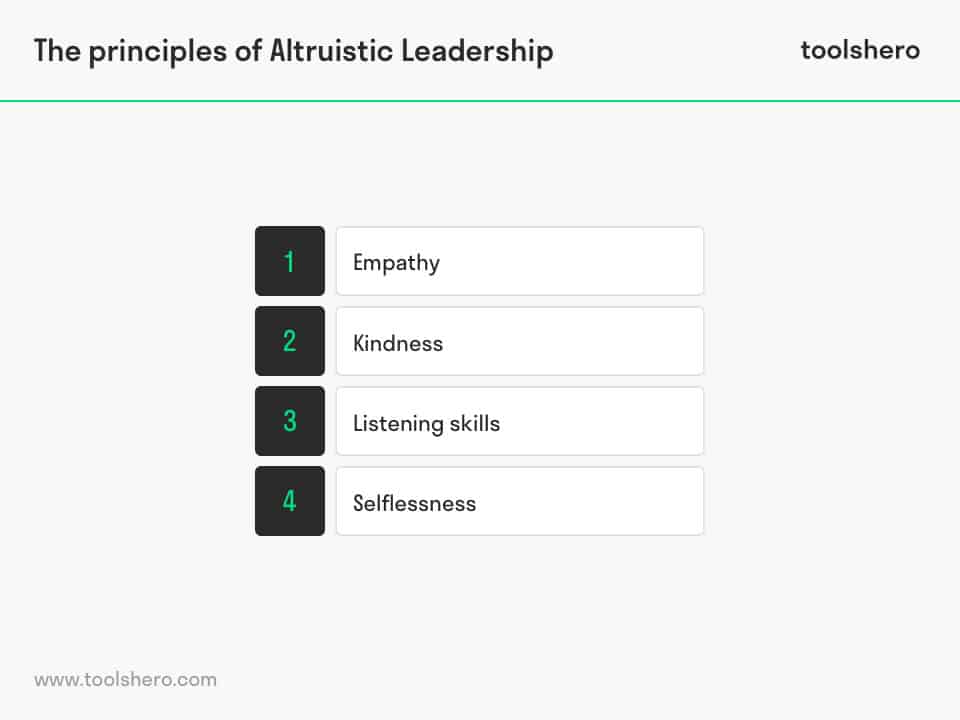Altruistic Leadership Style explained

Altruistic Leadership Style: in this article, the Altruistic Leadership Style is explained in a practical way. Next to what it is, this article also highlights hte basic principles and the philosophy of Effective Altruism. After reading, you will have a basic understanding of this leadership style. Enjoy reading!
What is Altruistic Leadership?
Altruistic Leadership is defined as the guiding of others with the goal of improving their well-being or emotional state. Not much research has been done into Altruistic Leadership, and little is clear about the efficacy and structure of this leadership style. Yet, by combining the two definitions, a reasonably solid image may be formed of Altruistic Leadership.
Altruism was invented by the French philosopher Auguste Comte. He intended the word as an antonym of egoism. He derived it from the Latin word alteri, meaning others. In some situations, then, altruism means selflessness, unselfishness.
In practice, it refers to caring about the happiness of other people or animals. This provides a high quality of life and work.
Leadership is a practical skill held by a person or organisation and entails guiding and managing individuals, teams, or entire departments. Leadership may be considered a process of social influencing where a person – the leader – is given the means to carry out a common task.
The way in which the leader ensures these common objectives are reached is their individual way of leading. When altruism is combined with leadership, that means the leader’s focus is reaching the common objectives while leading in a selfless way, where the happiness of the employees is paramount.
The principles of the Altruistic Leadership Style
Assuming Altruistic Leadership actually meets the above definition, some basic principles can be inferred from the term. An Altruistic Leader should have these skills or traits, as well as general leadership qualities. The basic principles of the Altruistic Leadership style are:

Figure 1- The principles of the Altruistic Leadership Style
Altruistic Leadership : Empathy
Empathy is the ability to understand and feel what another person is experiencing; one’s ability to step into the shoes of another. An empathic manager has a good feel for their employees.
For this reason, empathy in leadership also means that the manager knows if the people they are trying to reach are actually being reached, and if they interpret the information in the right way. Without empathy, no effective team can be built, and team members or employees will not be inspired or remain loyal.
Altruistic Leadership : Kindness
An Altruistic Leader is friendly or kind and praises the things others have carried out well. Such a leader does not focus on the negatives, and does not criticise their employers. Friendliness is free, yet creates a lot of value for employees. Yet, friendliness is seldom listed as a desired trait for leadership programmes.
No systematic research has been done into this either, so we are left guessing as to the way things really are. It is clear, however, that friendliness can produce motivation and the employee’s full commitment to the job.
Altruistic Leadership : Listening Skills
A leader should be a good listener and be able to stimulate communication within the team or on the job. A good atmosphere for communication is important. After all, in an environment where employees do not communicate, it remains unclear what’s important to them and whether they are happy.
This can lead to employees quitting their jobs, which leads to a loss of knowledge, skills, and expertise. Being a better listener helps with retaining employees and keeping morale high. Furthermore, good listening skills in the Altruistic Leadership style lead to:
- Improved mutual relationships between employees
- Improved relationships between employees and management
- Increased productivity
- Improved teamwork
- Increased loyalty
Altruistic Leadership : Selflessness
Good leaders are selfless. They facilitate the success of others, take care of the well-being of others, and ensure that common objectives are reached, while keeping circumstances optimal. They don’t expect anything in return for these good deeds. Good leadership makes others feel valued.
Altruistic Organisation
Various examples can be found of companies that have made altruism into a part of their business operations.
For example, there is a bakery in New York with a policy that encourages anyone to apply for a job there, regardless of age, education level, criminal record, etc. The revenues of such organisations often go to charity.
Altruistic organisations take the potential of people as their starting point and give these people second, third, or fourth chances in life.
These organisations are also described as engaging in social innovation. Social innovation may be defined as solutions such as products, services, models, processes, markets, which satisfies a social need at the same time. In other words, social innovation is good both for society as a whole and for the individual.
Altruistic Leadership in an altruistic organisation is not very common, and neither is selflessness. Most business models and company structures, after all, are not designed to encourage or stimulate altruistic behaviour.
Effective Altruism
Effective altruism is a philosophy and a social movement, as well as a lifestyle, in which logical reasoning and evidence are used to devise methods that are effective for helping others. It encourages people to consider all possible actions that may have a positive impact on others.
The example of the altruistic organisation is an example of effective altruism. The majority of the leaders who have adopted Altruistic Leadership as their personal style, however, are active in the non-profit sector.
Effective altruism differs from other philanthropic activities by its focus on increasing value for others. The philosopher Peter Singer has had a large role in the creation of the effective altruism movement.
In one of his books, he claimed that all people have a moral obligation to donate more to charity, because extreme poverty still exists. He personally donates a third of his salary to charity.
Job Choice
Altruists consider the moment you choose a career to be an important factor determining the amount of good things you can do in your life.
People can do a lot for society, both directly and indirectly. For example, a person can deliver services directly to someone else.
Indirectly means using the money earned with a job to do good for others. A strategy may then be to make a lot of money in business, then using all that money for charity.
Learning Altruistic Leadership
There are simple things that anyone can do to make things easier or better for someone else. They include small things like asking how someone is doing, offering a helping hand, or making a compliment.
A leader who wants to develop an Altruistic Leadership style need not strive to be like people such as Gandhi or Mandela, but must be convinced of the power of placing others first.
Ask yourself the following questions:
- Does other people’s success make me happy?
- Am I motivated and passionate about helping others? Does doing so provide me with satisfaction?
- Do I help people wherever I can?
- Do I help someone every day?
Now it’s your turn
What do you think? Do you recognise the explanation about Altruistic Leadership? Do you recognise any clear advantages and disadvantages to using this leadership style? Do you believe being good to others pays off as better company results? Do you have any tips or additional comments?
Share your experience and knowledge in the comments box below.
More information
- Axelsson, S. B., & Axelsson, R. (2009). From territoriality to altruism in interprofessional collaboration and leadership. Journal of interprofessional care, 23(4), 320-330.
- Miller, L. M., & Carpenter, C. L. (2009). Altruistic leadership strategies in coaching: A case study of Jim Tressel of the Ohio State University. Strategies, 22(4), 9-12.
- Sendjaya, S., Sarros, J. C., & Santora, J. C. (2008). Defining and measuring servant leadership behaviour in organizations. Journal of Management studies, 45(2), 402-424.
- Sosik, J. J., Jung, D., & Dinger, S. L. (2009). Values in authentic action: Examining the roots and rewards of altruistic leadership. Group & Organization Management, 34(4), 395-431.
How to cite this article:
Janse, B. (2019). Altruistic Leadership Style. Retrieved [insert date] from Toolshero: https://www.toolshero.com/leadership/altruistic-leadership/
Original publication date: 08/15/2019 | Last update: 10/26/2023
Add a link to this page on your website:
<a href=”https://www.toolshero.com/leadership/altruistic-leadership/”>Toolshero: Altruistic Leadership Style</a>












